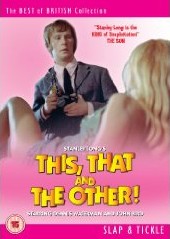- This essay will inevitably contain spoilers!
'THIS, THAT AND THE OTHER!' (1969)

- A review by Richard Harrison (2010)
If one took a carelessly selected random sample of British cinema in
the years 1969-1975 one could labour under the erroneous impression
that a) they all were about sex, b) they were always aimed at
representing youth culture and c) they were all about sex. In fact,
though there are many exceptions, British cinema in this period was one
in turbulent transition as the hedonistic Sixties gave way to the
unsettled Seventies with an increasing reliance on technology when
employment relied on manual work. A consideration of some of the
British films released in 1969 alone provides interesting food for
thought- two Carry On films, Battle of Britain, The
Italian Job, Kes, several Hammer horror films, Women In
Love, the Bond film On Her Majesty’s Secret Service and
last (and by all means least) the pointless re-make of Goodbye, Mr.
Chips. The interesting thing is to what extent these films
represent the era in which they were made. Some do (one thinks of Carry
On Camping) and some don’t (The Battle of Britain, for
example). To the shortlist of those that seem to wholeheartedly endorse
the values of the time one can add A Promise of Bed known by
the far less ostentatious title of This, That and the Other!.
A film that is typical of its director’s penchant for sexploitation, This,
That and the Other! is a real curiosity in that it seems (in its
opening five minutes) to be hopelessly predictable yet swiftly moves on
to do more interesting things with its unashamedly sex-dominated
content. The structure of the film is threefold- a trio of stories are
presented which are loosely and smoothly connected through the brief
presence of a previous character in the next vignette. Thus, Dennis
Waterman in the opening segment is watched from a window by loner
Victor Spinetti who is then the central character in the next mini
narrative. Overall, the film establishes an aura of sexual
misunderstanding coupled with fantasy, its content becoming
continuously more surreal (if not explicit- flesh is shown
unflinchingly throughout the film). If the content represents its era,
the soundtrack (which could become the new dictionary definition of
‘groovy’) also shackles This, That and the Other! to the late
1960s. Also supporting the fact that this is firmly a film at the end
of the swinging Sixties is the inclusion of actors familiar from other
roles- most notably a scene stealing performance by Alexandra Bastedo,
a familiar face at the time from cult classic series The Champions.
One of the most refreshing things about a film like This, That and
the Other! is its sheer amount of ideas- each episode of the
tripartite structure has something to commend it, the poignancy of the
second (where again the initial premise is subverted in a fashion that
is little short of genius) is offset by the third, where nothing is
certain, its surrealism reminiscent of a poor man’s Bunuel. From the
title, the era and the cast of the film as a whole one’s expectations
are not high, and one could be forgiven for approaching the film with a
wearied sense of needing to endure rather than enjoy it. However,
throughout the very modest running time (78 minutes) the film doesn’t
bore but intrigues, its unexpected events being a source of continual
delight. In more recent years British cinema has overall become staid,
predictable and politically correct- a very bad and unsatisfying
combination. A little over forty years ago, however, things were
different, and it is this difference that makes This, That and the
Other! far more interesting than many more recent films, British or
otherwise.
This, That and the Other! is available on DVD
from Odeon Entertainment.
Back
Home

